While modern digital photography provides a quick way to capture a Kodak moment, ease is not what Port Townsend photographer Jason Bledsoe desires.
This item is available in full to subscribers.
We have recently launched a new and improved website. To continue reading, you will need to either log into your subscriber account, or purchase a new subscription.
If you had an active account on our previous website, then you have an account here. Simply reset your password to regain access to your account.
If you did not have an account on our previous website, but are a current print subscriber, click here to set up your website account.
Otherwise, click here to view your options for subscribing.
* Having trouble? Call our circulation department at 360-385-2900, or email our support.
Please log in to continue |
|
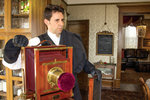
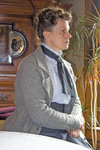
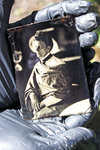
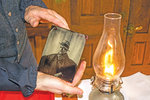
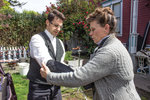

While modern digital photography provides a quick way to capture a Kodak moment, ease is not what Port Townsend photographer Jason Bledsoe desires.
Bledsoe, a shipwright by day, makes Wet Plate Collodion photographs in his spare time, demonstrating the difficult and unpredictable process to fellow photographers and at educational events.
“It is definitely a ritual,” Bledsoe said. “It is not quick and dirty. It is worth taking the time to do, but you have to put the work into it.”
During a recent demonstration at the Old Consulate Inn in Port Townsend, it took Bledsoe a day to prepare the chemicals for the process and another six hours the day of the shoot to set up the equipment.
“It is a challenge above and beyond anything I have ever done in photography before, and that is what keeps me at it,” he said. “I love that challenge. After all that work, it is extremely gratifying to pull a good image and very rare.”
The process begins with pouring salted collodion, a flammable and syrupy solution, onto a very clean piece of glass that is theng dipped into a bath of silver nitrate, Bledsoe said.
The halide salts in the collodion mix with the silver in the bath to form a light-sensitive emulsion. The plate, in turn, is placed into a camera dripping wet and must be exposed, developed and fixed before the plate dries. That is why it is called wet plate. If the plate dries out, the emulsion loses its sensitivity to light altogether and the plate is ruined.
“Once it’s dry it is done,” said Nancy Frye, a wet plate collodion enthusiast from Kingston who works with Bledsoe. “You might as well scrub it off and start over.”
It is important to ensure the lens cap remains on while the plate is loaded in the camera, Frye said.
“When the lens cap comes off you are exposing. When it goes back on you are done.”
The image is struck by light which can take anywhere from 1.5 seconds to several seconds depending on the quality of the light, the age of the chemistry and the temperature of the silver, Bledsoe said.
There is a lot of science involved, but the process is mostly art, Frye said.
“It is magic. How warm is your day? How is your humidity? How long have you been using this chemistry today? You really have to gauge your exposure times.”
This process is orthochromatic which means it is highly sensitive to blue and ultraviolet light and not sensitive to red light, Bledsoe said.
“The difference between this process and a modern process is the way it picks up color,” Frye said.
Reds become black and blues become pale, she said.
“With blue eyes it might come out looking like Little Orphan Annie. If it is a beautiful blue dress it might come out looking like a white dress. You just never know.”
There are a lot of variables to keep track of, and there are no calibrated light meters, so the photographer is constantly making educated guesses and judging proper exposure as it changes throughout the day, Bledsoe said.
“Typically, once I have my base exposure figured out, it is only a matter of making minor adjustments throughout the day as the light and chemicals change,” he said. “It is forever a process in flux and a huge part of my job is to keep up with those changes.”
It can be immensely difficult to pull good plates throughout the day as the process is extremely fickle and very easy to mess up, Bledsoe said.
Once the image is struck, the photographer takes the plate to the darkroom and develops it under a red safelight.
Proper development for positive images - tintypes and ambrotypes - takes only 15 to 20 seconds, Bledsoe said. Negatives take longer to build proper density for printing.
After the plate is developed it can be taken out into daylight and fixed.
In the fixing bath, the images change from a faint bluish latent negative to a positive image in a matter of seconds.
“This is my favorite part of the process because I get to watch the image come to life right before my eyes,” Bledsoe said. “It is a magical process to watch it turn into this beautiful photograph.”
From there, the image is washed and dried, hand-colored if requested, then varnished with a special formula containing gum sandarac and lavender oil.
The Tintype must then dry for about 48 hours before it is completed, Bledsoe said.
After all this work, Bledsoe then often will never see the photos again.
“It is a little heartbreaking,” he said. “All of my best images I don’t have. They are gone. But somebody else gets to enjoy those and share it with other folks.”
Getting others interested in the medium in this way makes it all worthwhile, Bledsoe said.
An intimate process
If he ever opens up a dedicated studio, Bledsoe will incorporate an informal area where he can sit and get to know each person he is photographing to get a feel for who they are and what they like and put that into their photograph to give them something really unique, he said.
“I just like the human interaction of chatting with them and getting to know them,” Bledsoe said. Trying to do that on the go can be challenging.
“A lot of times we are at an event and it is hurry, hurry, hurry. We are taking a new group or new person every 15 or 20 minutes so everything has got to be spot on.”
Because of the quick turnaround, Bledsoe relies on three assistants to get the process done.
Bledsoe would rather spend about an hour with each subject, he said.
Sitting still
The hardest part for the subject is to sit still through a shoot, Bledsoe said.
“The exposure can run, even outdoors, up to eight seconds, and indoors up to 16 seconds. It is really difficult to hold the pose and not wiggle.”
While that may seem like just a few seconds, it can be very difficult for a person to stay completely still for that long, or to hold a facial expression, Bledsoe said.
“People tend to lose their happiness, their facial expression gets kind of dour after doing two or three takes locked into the brace and holding still. But, it looks traditional that way.”
That isn’t to say nobody smiled in 19th century photos, or that it was uncouth to do so, he said.
“Sometimes it just took so long to get the exposure, it is just very difficult for people. They are tired.”
But all that work by photographer and subject pays off when the photo is developed, Frye said.
“It is very crisp. The detail is insane. There is no pixelation. It is really amazing.”